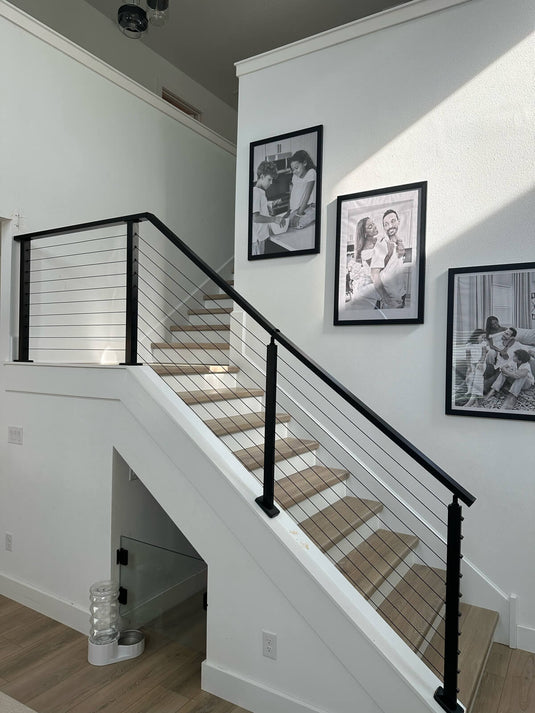TABLE OF CONTENTS
Maximizing the Lifespan of Your Cable Deck Railings: Pro Tips and Tricks
Cable deck railings are a beautiful addition to any home. They give you that clean, modern look and keep you safe without blocking your view. But just like anything else, they need a little love to stay looking great. Spending a bit of time on maintenance now will save you headaches later and keep your deck looking sharp and feeling secure for years. This guide will walk you through the simple steps to protect your investment and maximize the lifespan of your cable deck railings.
 Customer photo shared by Tina Fanelli
Customer photo shared by Tina Fanelli
Why Bother with Maintenance?
It’s tempting to look at shiny stainless steel and think it’s bulletproof, but a little care can make a huge difference. Good maintenance is about more than just keeping things pretty; it's about safety. Over time, those cables can loosen up and start to sag, which can be dangerous. Plus, everyday dirt, pollen, and grime can settle on the steel and cause some ugly staining if you let it sit. A simple routine keeps these small issues from becoming big, expensive ones.
Know What You’re Working With
Before you start, it’s helpful to know the basic parts of your railing. A cable railing system has three main components that are critical for structural stability, and each needs a little attention.
1️⃣ The Cables: These are the thin stainless steel wires that give you that barely-there, modern look.
2️⃣ The Posts: These are the anchors of the whole system. They're what hold everything up and are usually made of wood, aluminum, or stainless steel.
3️⃣ The Hardware: These are all the small but important bits—the tensioners and fixed ends—that grip the cables and keep them tight.
It All Starts with Good Materials
Honestly, the best way to get a long life out of your cable deck railings is to choose quality materials from the very beginning. Going cheap on the initial purchase is a guaranteed way to create problems for yourself down the line.
Choosing the Right Stainless Steel Cables
Not all stainless steel is the same. For outdoor stuff, you’ll mostly see two types: Grade 304 and Grade 316. Grade 304 is decent, but for anything outside, Grade 316 is the hands-down winner, especially if you live anywhere near the coast.
Grade 316 has a little bit of an element called molybdenum mixed in. It sounds fancy, but all it does is make the steel way more resistant to rust from salt and other chemicals. If the ocean is just a few miles away, Grade 316 isn’t just a good idea—it’s a must. The salty air will cause ugly rust-colored stains on cheaper steel in no time. Even if you're not near the water, 316 steel gives you extra protection against pollution and de-icing salts, so it’s a smart buy.
Don't Forget the Posts
Your posts are doing all the heavy lifting, so they matter just as much as the cables. Pressure-treated wood is a common choice because it’s affordable, but you’ll have to stain or seal it every few years to keep it from rotting. If you want something you can pretty much forget about, look at aluminum or stainless steel posts. They cost more upfront but will stand up to the weather way better than wood.
Build Your Vision
Turn your ideas into reality with a custom cable railing solution designed just for your home.
Start My Project →Your Simple Maintenance Routine
A little bit of regular maintenance is all it takes to keep your railings in great shape. A quick check-up a couple of times a year is usually enough.
Step 1: Keep Them Clean
A good cleaning isn’t just for looks; it’s your best defense against rust and stains. Dirt and salt from the air can sit on the steel and eventually eat away at its protective coating.
Cleaning them twice a year is perfect for most homes. If you're near the coast, aim for every three or four months. The steps are easy:
- First, just spray the railings down with a hose to get any loose gunk off.
- Next, use a soft cloth with some warm, soapy water (regular dish soap is fine) to gently wipe everything down—cables, posts, and all the little hardware bits.
- For any tough spots, a gentle, non-scratchy cleaner like Bon Ami can work wonders. Just try it on a hidden spot first to be safe.
- Finally, rinse everything really well with fresh water. You don’t want to let soap dry on the steel, as it can leave spots.
Step 2: The Yearly Walk-Around
Once a year, take a slow walk around your deck and really look at your railings. Give each post a good wiggle to make sure it’s still solid. Look closely at the cables to see if there are any broken strands or fraying. Check all the nuts and bolts to make sure nothing has wiggled loose. Finding a wobbly post or a loose piece of hardware early is an easy fix that can prevent a big problem later.
The Trick to Keeping Cables Tight
One thing that’s unique to cable railings is making sure they stay tight. Over time, the cables can stretch a tiny bit, which leads to sagging. Saggy cables don’t just look sloppy; they’re a safety issue because the gaps can become too wide.
A good test is to see if a 4-inch ball can fit through the cables — if it does, they’re too loose. Another quick check is to push on the middle of the longest cable run. If it gives way by a few inches, you’ll need to tighten them up.
Most systems have tensioners built right into the hardware at the end of the posts. Usually, you just need a wrench to turn a nut, which will pull the cable tighter. Just be careful not to overdo it. Pulling the cables too tight can put a lot of stress on your posts and make them bend. A few turns is usually all you need to get that clean, straight look back.
How to Handle Common Problems
Even with good care, you might see a few minor issues pop up. Here’s what to do.
If you notice little brownish-red specks on your stainless steel, don’t freak out. It’s probably just what’s called “tea staining.” It’s a surface-level discoloration and doesn’t usually affect the structural integrity of the stainless steel. However, if left untreated for a long time, it may worsen and lead to more serious corrosion. A quick scrub with a good stainless steel cleaner will usually get rid of it.
If you have wood posts, keep a close eye on the spots where the hardware attaches. Water can get in there and cause rot. Make sure those areas are sealed well. If you find any mushy spots, it’s best to deal with them right away to keep your railing strong.
How Your Location Matters
Where you live makes a difference. As we talked about, if you’re near the coast, the salty air means you’ll need to clean more often and should definitely have high-quality materials.
But even if you’re inland, living near a busy city or industrial area can mean more pollutants in the air that can harm your railings, so more frequent cleaning is still a good idea. And if you’re in a heavily wooded area, you might have to deal with mildew on your posts, but a good deck cleaner can take care of that.
 Customer photo shared by Adam Ross
Customer photo shared by Adam Ross
Conclusion
Your cable deck railing is a beautiful part of your home that adds value and makes your outdoor space more enjoyable. Taking care of it is surprisingly simple. By choosing good materials from the start, giving them a simple cleaning now and then, and doing a quick yearly inspection, you can easily extend the lifespan of your railings. This little bit of effort will make sure your view stays safe, secure, and stunning for many, many years.




